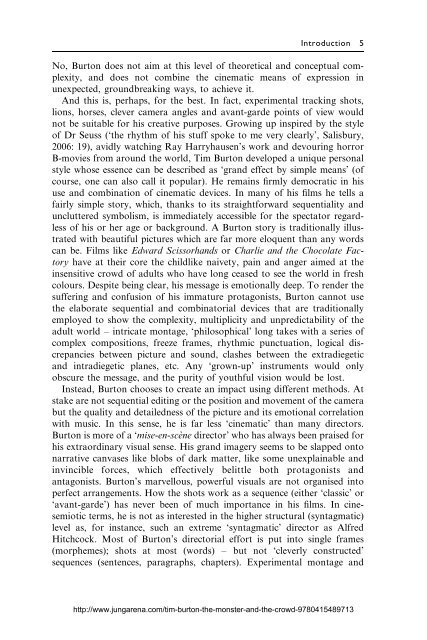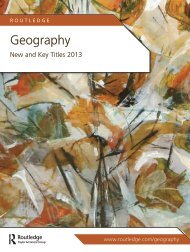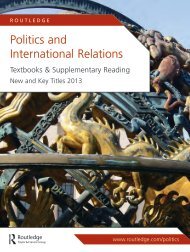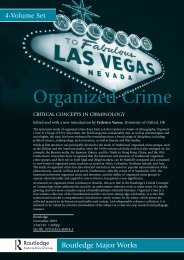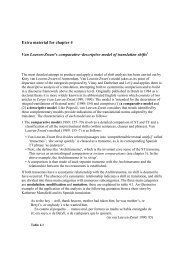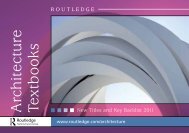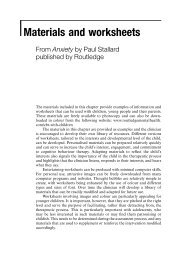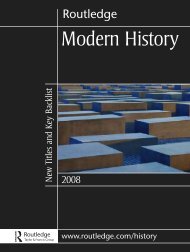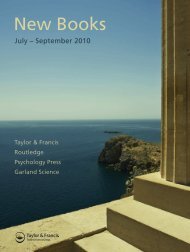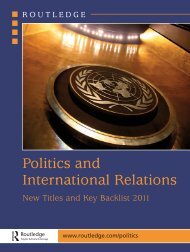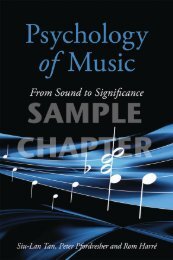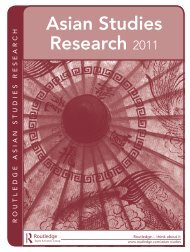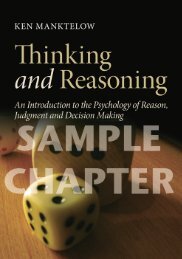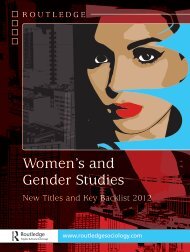Tim Burton: The Monster and the Crowd - A Post-Jungian Perspective
Tim Burton: The Monster and the Crowd - A Post-Jungian Perspective
Tim Burton: The Monster and the Crowd - A Post-Jungian Perspective
Create successful ePaper yourself
Turn your PDF publications into a flip-book with our unique Google optimized e-Paper software.
Introduction 5<br />
No, <strong>Burton</strong> does not aim at this level of <strong>the</strong>oretical <strong>and</strong> conceptual complexity,<br />
<strong>and</strong> does not combine <strong>the</strong> cinematic means of expression in<br />
unexpected, groundbreaking ways, to achieve it.<br />
And this is, perhaps, for <strong>the</strong> best. In fact, experimental tracking shots,<br />
lions, horses, clever camera angles <strong>and</strong> avant-garde points of view would<br />
not be suitable for his creative purposes. Growing up inspired by <strong>the</strong> style<br />
of Dr Seuss (`<strong>the</strong> rhythm of his stuff spoke to me very clearly', Salisbury,<br />
2006: 19), avidly watching Ray Harryhausen's work <strong>and</strong> devouring horror<br />
B-movies from around <strong>the</strong> world, <strong>Tim</strong> <strong>Burton</strong> developed a unique personal<br />
style whose essence can be described as `gr<strong>and</strong> effect by simple means' (of<br />
course, one can also call it popular). He remains ®rmly democratic in his<br />
use <strong>and</strong> combination of cinematic devices. In many of his ®lms he tells a<br />
fairly simple story, which, thanks to its straightforward sequentiality <strong>and</strong><br />
uncluttered symbolism, is immediately accessible for <strong>the</strong> spectator regardless<br />
of his or her age or background. A <strong>Burton</strong> story is traditionally illustrated<br />
with beautiful pictures which are far more eloquent than any words<br />
can be. Films like Edward Scissorh<strong>and</strong>s or Charlie <strong>and</strong> <strong>the</strong> Chocolate Factory<br />
have at <strong>the</strong>ir core <strong>the</strong> childlike naivety, pain <strong>and</strong> anger aimed at <strong>the</strong><br />
insensitive crowd of adults who have long ceased to see <strong>the</strong> world in fresh<br />
colours. Despite being clear, his message is emotionally deep. To render <strong>the</strong><br />
suffering <strong>and</strong> confusion of his immature protagonists, <strong>Burton</strong> cannot use<br />
<strong>the</strong> elaborate sequential <strong>and</strong> combinatorial devices that are traditionally<br />
employed to show <strong>the</strong> complexity, multiplicity <strong>and</strong> unpredictability of <strong>the</strong><br />
adult world ± intricate montage, `philosophical' long takes with a series of<br />
complex compositions, freeze frames, rhythmic punctuation, logical discrepancies<br />
between picture <strong>and</strong> sound, clashes between <strong>the</strong> extradiegetic<br />
<strong>and</strong> intradiegetic planes, etc. Any `grown-up' instruments would only<br />
obscure <strong>the</strong> message, <strong>and</strong> <strong>the</strong> purity of youthful vision would be lost.<br />
Instead, <strong>Burton</strong> chooses to create an impact using different methods. At<br />
stake are not sequential editing or <strong>the</strong> position <strong>and</strong> movement of <strong>the</strong> camera<br />
but <strong>the</strong> quality <strong>and</strong> detailedness of <strong>the</strong> picture <strong>and</strong> its emotional correlation<br />
with music. In this sense, he is far less `cinematic' than many directors.<br />
<strong>Burton</strong> is more of a `mise-en-sceÁne director' who has always been praised for<br />
his extraordinary visual sense. His gr<strong>and</strong> imagery seems to be slapped onto<br />
narrative canvases like blobs of dark matter, like some unexplainable <strong>and</strong><br />
invincible forces, which effectively belittle both protagonists <strong>and</strong><br />
antagonists. <strong>Burton</strong>'s marvellous, powerful visuals are not organised into<br />
perfect arrangements. How <strong>the</strong> shots work as a sequence (ei<strong>the</strong>r `classic' or<br />
`avant-garde') has never been of much importance in his ®lms. In cinesemiotic<br />
terms, he is not as interested in <strong>the</strong> higher structural (syntagmatic)<br />
level as, for instance, such an extreme `syntagmatic' director as Alfred<br />
Hitchcock. Most of <strong>Burton</strong>'s directorial effort is put into single frames<br />
(morphemes); shots at most (words) ± but not `cleverly constructed'<br />
sequences (sentences, paragraphs, chapters). Experimental montage <strong>and</strong><br />
http://www.jungarena.com/tim-burton-<strong>the</strong>-monster-<strong>and</strong>-<strong>the</strong>-crowd-9780415489713


